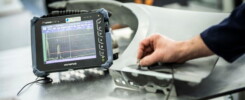Thermography in Mining: A Game-Changer for Safety, Maintenance, and Efficiency
In the mining industry, safety, reliability, and efficiency are non-negotiable. With heavy machinery, high-powered electrical systems, and demanding operating conditions, even a minor fault can escalate into a major hazard or cause costly downtime. That’s where thermography steps in—a powerful, non-contact diagnostic tool that’s revolutionising predictive maintenance and safety monitoring in mining operations.
What is Thermography?
Thermography, also known as infrared thermal imaging, involves using infrared cameras to detect heat emitted from surfaces. Every object emits infrared radiation (heat), and by capturing this radiation, thermographic cameras produce visual heat maps that show temperature variations—making invisible problems visible.
In a mining context, these thermal images can reveal overheating motors, misaligned bearings, failing electrical components, and even signs of friction or poor lubrication—often before the issue causes equipment failure or poses a safety risk.
Key Benefits of Thermography in Mining
Early Fault Detection and Preventive Maintenance
Mines operate with complex electrical systems, heavy-duty motors, conveyor belts, crushers, and ventilation fans—all prone to wear and tear. Thermography allows technicians to identify hotspots that indicate potential equipment failure, such as:
Loose or corroded electrical connections
Overloaded circuits or transformers
Misaligned or overheating bearings
Blocked ventilation or cooling systems
By addressing these issues early, mining companies can avoid catastrophic failures, improve equipment availability, and plan repairs proactively.
Improved Worker Safety
Mining environments are inherently hazardous. Electrical faults or overheating equipment can lead to fires, arc flashes, or mechanical failure. Thermographic inspections reduce the need for hands-on checks in high-risk areas and help prevent dangerous breakdowns before they occur.
Reduced Downtime and Maintenance Costs
Unplanned equipment failure can halt operations, leading to major production losses. Thermography supports a predictive maintenance strategy, enabling teams to schedule repairs during planned shutdowns, thereby minimising costly interruptions.
Energy Efficiency and Compliance
Thermal imaging can detect energy losses in electrical panels and systems, helping mines optimise energy consumption and reduce operating costs. In some regions, thermographic inspections are also part of safety and environmental compliance requirements.
Data-Driven Decision Making
Thermal scans can be logged, analysed, and compared over time, providing valuable insights into asset performance. This data supports informed decision-making and improves asset lifecycle management.
Common Mining Applications for Thermography
Electrical panels and substations: Detect loose connections, overloaded phases, and failing components.
Rotating machinery: Monitor motors, pumps, gearboxes, and conveyor systems for abnormal heat patterns.
Processing plants: Check crushers, mills, and fans for signs of wear or inefficiency.
Ventilation systems: Ensure proper airflow and detect blockages or overheating components.
Structural integrity: In some cases, thermography can help detect water ingress or insulation failure in structures and enclosures.
In a high-stakes industry like mining, thermography offers a proactive and cost-effective way to maintain equipment, protect workers, and enhance operational efficiency. By integrating thermal imaging into routine maintenance and safety protocols, mines can significantly reduce risk, improve uptime, and optimise resource usage.
Thermography isn’t just a diagnostic tool—it’s a strategic advantage.

